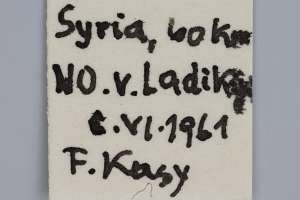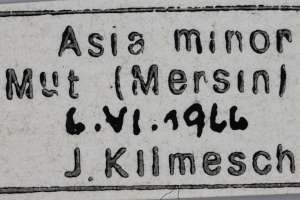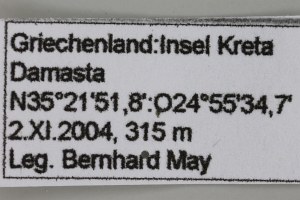Version 32 / 34 vom 12. Dezember 2022 um 12:38:10 von Michel Kettner
Länder:

 +5Kontinente:EUAS
+5Kontinente:EUAS


 +5Kontinente:EUAS
+5Kontinente:EUASInhalt
1. Lebendfotos
1.1. Falter
1-2: Zypern, Bezirk Paphos, westlicher Teil (bei Polis), 100 m, gebüschreiches Gelände, 26. Mai 2013, am Licht (det. & Fotos: Mike Hardman)Forum
3-4: Zypern, Bezirk Paphos, westlicher Teil (bei Polis), 100 m, gebüschreiches Gelände, 24. September 2012, am Licht (Fotos: Mike Hardman), det. Egbert Friedrich & Axel SteinerForum
5-6: Türkei, Karaman, Yesildere, 1200 m, Eichen Wald, 3. September 2014, am Licht (fot.: Özgür Koçak), det. Egbert Friedrich, conf. Dieter FritschForum
7: Griechenland, Samos, Kokkari, 20. Oktober 2014, 90 m, N 37°46'34", O 26°52'34" (det. & fot.: Bernhard May)
2. Diagnose
2.1. Männchen
1-2: zwei ♂♂, Daten siehe Etiketten (coll., det. & fot.: Egbert Friedrich)
3-4: ♂, Syrien, Daten siehe Etikett (fot.: Michel Kettner), coll. ZSM, "Klimesch-Sammlung"
5-6: ♂, Türkei, Daten siehe Etikett (fot.: Michel Kettner), coll. ZSM, "Klimesch-Sammlung"
2.2. Geschlecht nicht bestimmt
3. Weitere Informationen
3.1. Etymologie (Namenserklärung)
Die Art ist nach dem Entomologen Ole Karsholt benannt.
Fibiger: "I wish to express my particular gratitude to Ole Karsholt, who first recognised the new species as a noctuid moth ..."
3.2. Taxonomie
Die Gattung und Art wurden von Fibiger (2005) einer eigenen Familie (Micronoctuidae) zugeordnet, so auch noch in Band 12 der Noctuidae Europaeae (Fibiger et al. 2010).
3.3. Faunistik
Locus typicus: Türkei, Provinz Antalya, 40 km N Antalya, 5 km S Gündogmus, 1100 m.
Unter den Paratypen befinden sich außerdem Exemplare aus Griechenland von den Inseln Rhodos, Kos, Kreta und Samos. Die Art kommt außerdem auf Zypern vor.
3.4. Literatur
- Erstbeschreibung: Fibiger, M. (1997): Micronoctua karsholti gen. et sp. n.: an astonishingly small noctuid moth (Noctuidae). — Nota lepidopterologica 20 (1/2): 23-30 [Digitalisat auf www.archive.org].
- Fibiger, M., L. Ronkay, J.L. Yela & A. Zilli (2010): Noctuidae Europaeae. Volume 12. Rivulinae, Boletobiinae, Hypenodinae, Araeopteroninae, Eublemminae, Herminiinae, Hypeninae, Phytometrinae, Euteliinae, and Micronoctuidae. Including supplement to volumes 1-11. — 451 S.; Sorø (Entomological Press).




















